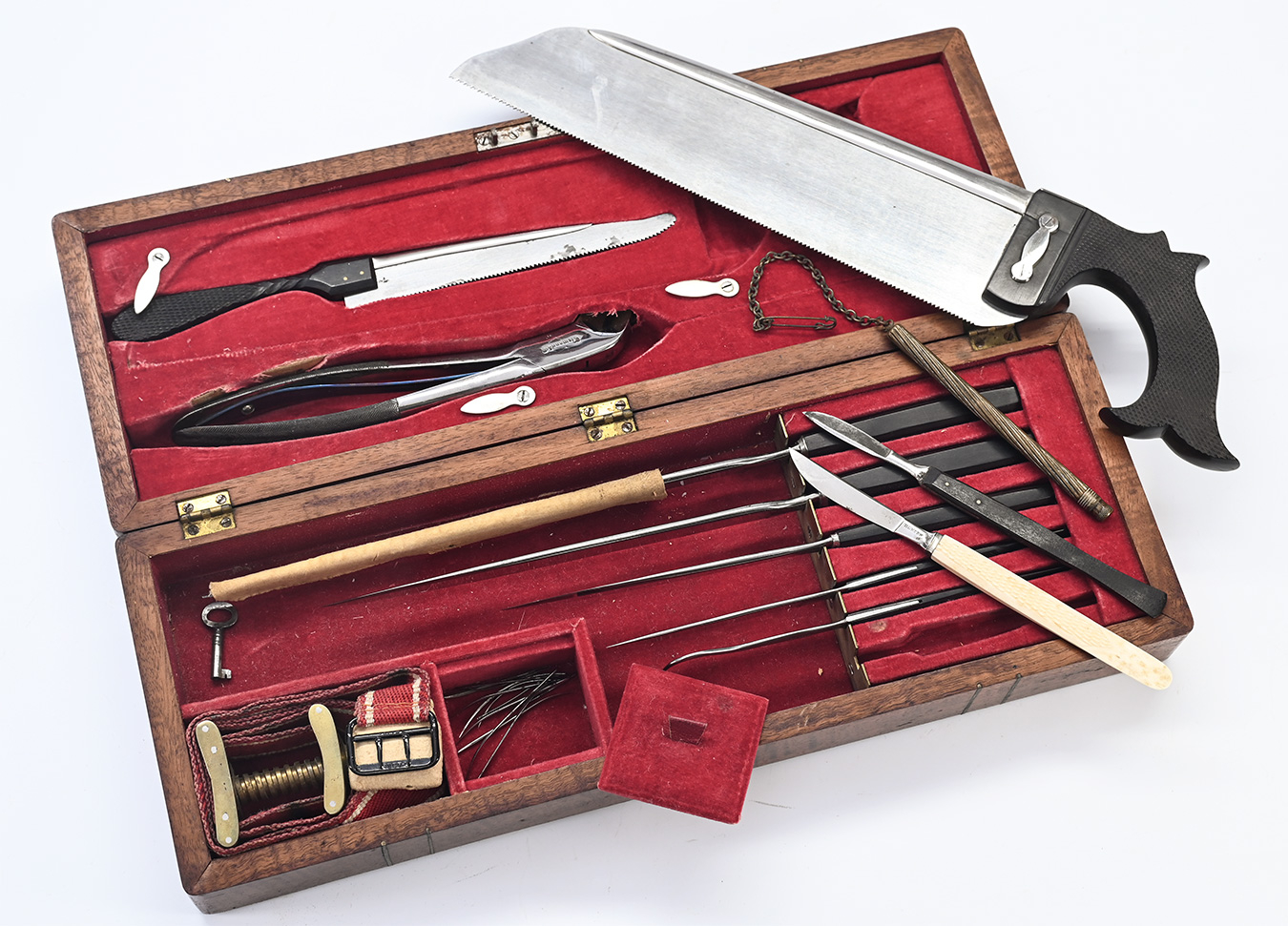site search
online catalog
CASED CIVIL WAR ERA AMPUTATION SET

$3,250.00 SOLD
Quantity Available: None
Item Code: 490-2573
This is a mid-nineteenth century, Civil War era amputation set in very nice condition. The wood box measures 15 inches long 5 ½ inches wide 2 ¾ inches tall and is fitted with two inlaid narrow brass bands encircling it at either end, raw corners, and a key lock. The wood has attractive grain with nice finish and no significant cracks or chips. The underside shows the remnant of black paper. The case is fitted with an oval brass escutcheon at top engraved with the name “Alford.”
The case has a red cloth lined interior with bottom compartments and a rack for scalpels and knives. The top is inlet to hold a capital saw with a fish-tail handle and a bone forceps, retained by swivel clips, with a lifting back metacarpal saw stored under the capital saw. The forceps is smaller and of different contour than the cutout. The two saws fit perfectly. The lower section of the box includes brass tourniquet with red and white web strap and 1855 patent buckle neatly stored in a rectangular compartment, and a number of surgical needles stored in a square compartment with red top and lifting tab. Three amputating knives of graduated size are stored in the rack, along with a smaller knife, tenaculum, and two scalpels, one of which matches the rest of the set with a black handle, the other with white. There is a small brass chain with double hook and cylindrical handle, likely a retraction device of some sort, perhaps one that wandered in from a dissection kit. The longest amputating knife has a cloth sheath.
Some instruments are unmarked. Two makers, Tiemann of New York and H.G. Kern of Philadelphia appear on others. The bone forceps is marked Tiemann & Co. in Old English, which dates to the early 1860s. Kern worked in Philadelphia on his own from 1837 to 1876 and then in partnership with a son until his death in 1889. His mark appears on some of the knives and scalpels. He was the second largest maker of medical sets and instruments in Philadelphia at the beginning of the Civil War. The bone forceps is smaller and of different contour than the cut-out for it, so we might expect that is the intruder, but the mix of makers is not unusual in sets coming out of doctors’ estates: relatives packing up an office or an attic are usually not discerning about what tool belongs in what box.
The blades of all the instruments are clean and bright. The handles are excellent. The tourniquet is excellent. The cloth lining has good color and just one hole, made by the forceps under the lid. There is no maker’s label in the case, but these were often printed labels simply glued to the interior and easily lost. The instruments include pretty much the full set needed for amputation procedures and display very well. [sr] [ph:m]
~~~~~~~~~~~~~~~~~~~~~~~~~~~~~~~~~~~
THIS ITEM, AS WITH ALL OTHER ITEMS AVAILABLE ON OUR WEB SITE,
MAY BE PURCHASED THROUGH OUR LAYAWAY PROGRAM.
CLICK HERE FOR OUR POLICIES AND TERMS.
THANK YOU!
Inquire About CASED CIVIL WAR ERA AMPUTATION SET
For inquiries, please email us at [email protected]
Most Popular
Historical Firearms Stolen From The National Civil War Museum In Harrisburg, Pa »
Theft From Gravesite Of Gen. John Reynolds »
Cavalry Carbine Sling Swivel »
Fine Condition Brass Infantry Bugle Insignia »
featured item
HISTORICAL FIREARMS STOLEN FROM THE NATIONAL CIVIL WAR MUSEUM IN HARRISBURG, PA
Please click on the photograph above to view a flyer containing information regarding a Model 1860 Henry Rifle and pair of cased presentation Colt Revolvers identified to Secretary of War Simon Cameron which were stolen from the museum on February… . Learn More »








